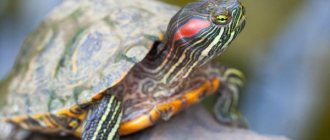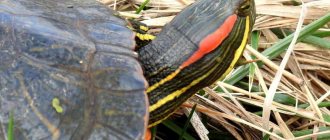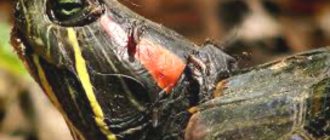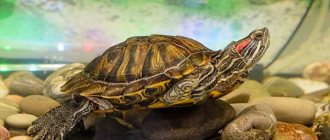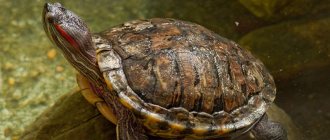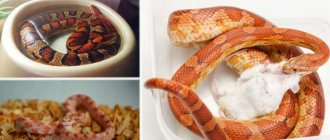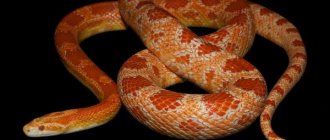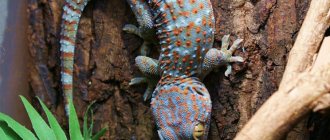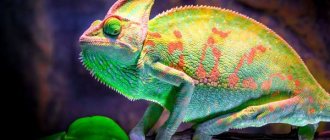Modern owners are not limited to just pets, and today in apartments you can find more exotic inhabitants, such as reptiles. Of course, not everyone decides to have crocodiles, iguanas or other rare representatives, but many people have land turtles. The most common pet in this category is the Central Asian tortoise - a slow, phlegmatic animal that is easy to keep. However, it is still a reptile, and not a cat or a dog, which means it needs certain conditions, feeding and care. What should future owners of such an unusual pet know?
About the habitat
The Central Asian tortoise received its name Testudo horsfieldii in honor of the American zoologist Thomas Horsfield. In nature, these reptiles are found in the southeast of Eurasia, in clayey and sandy areas, foothills, river valleys and agricultural lands.
When selecting a site for habitat, the land turtle gives preference to moist soil, in which it digs holes and arranges its home. Unfortunately, representatives of this species turned out to be of interest to poachers, so today the Central Asian land tortoise has become an endangered species and is on the pages of the Red Book.
Owner reviews
Despite the relatively weak development of brain cells, in the process of intelligence testing, land turtles showed fairly high results. As practice shows, the Central Asian tortoise easily learns and is even able to find a way out of a not too complicated labyrinth, and also finds a place for heating and feeding. In this regard, the land turtle is superior in intelligence to all tested snakes and lizards.
The conditions for keeping the Central Asian turtle are very simple, so this pet is perfect even for children. A reptile of this species loves to burrow into the ground, so you need to provide a bedding of sufficient height in the terrarium or aquarium. Sand, peat chips or coconut shavings can be used as a bedding substrate.
As practice shows, using clean river sand as bedding is undesirable . It is best to use special mixtures for this purpose, represented by sand with peat chips or earth.
Several large and flat stones inside the terrarium look very original, which very effectively help the Central Asian tortoise file off its claws and can be used as a clean surface for providing food. Compliance with the maintenance regime allows the exotic pet to live for several decades.
Return to content
What do representatives of the species look like?
3-centimeter babies are born, and their growth does not stop throughout their lives. The size of adult reptiles varies from 15 to 25 cm. But most often small individuals are found, and males are inferior to females in size - they do not grow more than 20 cm. The length of females varies from 15 to 23 cm.
Adult turtles have a small grayish-brown head The carapace is round in shape, with a significant convexity. The color palette of carapaces among representatives of this species is not very diverse - there are individuals with a shield of sandy, greenish, brown tones with dark spots without clear contours.
The limbs are colored in the same tone as the head. The peculiarity of the Central Asian “land animals” is the presence of four fingers, while representatives of other species have only three.
Litter
As I already said, Central Asian turtles love to dig. It’s good if you have the opportunity to purchase a tall terrarium in order to spread the “soil” in a thick layer. But the layer thickness in any case should not be less than 3cm.
As a filler, you can use shavings, dust-free soft hay, corn or wheat cat litter - in pure form or randomly mixing them.
As a filler, you can use shavings (fluffy, large, soft, and not small loose sawdust), dust-free soft hay, corn or wheat cat litter - in pure form or randomly mixing them. A small amount of wood filler for cats can be added to the selected type of “soil” to increase the hygroscopicity of the resulting mixture. But it is worth considering that some turtles tend to eat bedding, so you need to be careful with wood filler: unlike other proposed options, wood pellets, swelling in the intestines, can cause obstruction.
European tortoisekeepers often use grass food for rabbits in granules - it is edible, absorbs feces well, and smells good. However, in Russian conditions this may not be a very budget option.
How to buy a healthy turtle
In order not to encounter difficulties at the first meeting, you should pay close attention to the health of your future pet already at the time of purchase. What should you immediately pay attention to?
- The behavior of a reptile is how active it behaves, how it moves, and whether it moves at all. If a turtle has poor coordination of movement, this can be detected almost immediately.
- Appearance – the carapace and plastron must not be damaged, chips and cracks are unacceptable. A healthy individual has skin without cracks, wounds, or spots. Their presence (not related to the breed feature) on the shields is also suspicious.
- Armor shields must have the appropriate shape, the shields are even, tightly adjacent to each other, without gaps.
- The oral cavity also makes it possible to assess the condition of the reptile - if the mucous membranes are light pink, without plaque, and no viscous salivary fluid is secreted, then everything is fine with the turtle.
- There should be no mucus released from the nasal cavity.
It is important to take care of transporting your newly adopted pet. If you are driving/walking nearby and it’s summer outside, you can place the reptile in a cardboard box with several sheets of paper on the bottom. In the autumn-winter period, it is better to protect the turtle by covering it with a warm cloth and placing a heating pad in the container.
In Primorye they say: “A harsh winter means wait for a cat.”
Winter is the most difficult period in the life of these wild cats. Having thin and short paws - this can be seen even from the photo - the Amur cat is practically unable to move through deep, loose snow. Only present day saves. If it is not there, the animals are unable to hunt and starve for weeks.
The reserve of fat that the Amur cat stores in advance in the fall helps. With an average weight of 4 kg, the animal can increase its weight to 8–9 kg, significantly changing in appearance, practically turning into a ball of fur.
Director of the Lazovsky Nature Reserve Alexander Laptev tells interesting facts: the Amur forest cat, it turns out, in especially snowy winters operates in village chicken coops, where it feeds on poultry - chickens, ducks. In particular, such cases became more frequent in March 2010, when heavy snowfalls made it very difficult for Amur cats to feed themselves.
“The Far Eastern forest cat is not dangerous for humans. As a rule, when people approach, he runs away,” says Alexander Laptev. As soon as the first warmth sets in and the snow begins to melt, the forays of Far Eastern cats into the villages stop.
How to tame a Central Asian turtle
Reptiles do not easily adapt to new conditions and often experience severe stress. They lose their appetite, often hide their heads and show minimal activity. It often takes more than one month for a turtle to get used to people and housing. The owner can speed up this process by doing the following:
- feeding your pet a nutritious and tasty dish of fresh salad, grated fruits - pears, bananas, apples, persimmons, pieces of carrots with vanilla, will definitely awaken the reptile's appetite;
- organizing a bath with warm water - the procedure helps to relax the animal and also improves digestion.
Main enemies
But the number of turtles was also affected by deliberate actions of people against these harmless animals. In Turkmenistan, there is a belief among a certain part of the population that the turtle is the filthiest animal. This belief was previously accompanied by a ban on touching the turtle. Today it is combined with the aggressiveness of teenagers who destroy these slow creatures. In Uzbekistan, the origin of the turtle is linked in legend to a rogue merchant. He so shamelessly weighed down the buyers that they became indignant and cried out to Allah. Allah got angry, took two pans of the scales on which the merchant was underweighting the flour, and squeezed the swindler with them. “You will forever bear these evidences of your shame,” Allah concluded. Between the scales the merchant had only his head and limbs left sticking out, and he turned into a turtle. It must be assumed that such a legend did little to promote people’s caring attitude toward turtles. Also, a large number of turtles die from the feet of artiodactyl animals and birds of prey.
Keeping a turtle in a terrarium
A turtle, even a land turtle, should not live freely or in a box; it requires more comfortable conditions - a spacious 60-100-liter terrarium, the width of which must accommodate at least three reptiles. Naturally, only one individual should live in such a container. Humidity should be between 70-80%. It is important that there are two corners in the tank - warm and cool:
- Warm . Can be equipped by installing an electric lamp with a power of 40-100 W. The air temperature must be stable - not lower than 25° and not higher than 35°C. To prevent the turtle from getting burned, the lighting device should be installed no lower than 15-20 cm from the bottom of the tank.
- Cold. In this area the temperature should be lower than in the rest of the container, but not lower than 20°C. Daylight hours for a reptile should last at least 10-12 hours. It is advisable to turn off the lighting at night.
Like other turtles, Central Asian land turtles need ultraviolet light - the rays provide the animal with vitamin D3, which is involved in the full absorption of calcium. Therefore, it is worth taking care of a UV lamp, the spectrum of which is UVB 10%.
Priming
Representatives of this breed love to dig in the ground - they do this often and with special diligence, so it is better to cover the bottom of the tank with a 15-centimeter layer of soil material - sand, hay, wood chips, small pebbles or garden soil. It is recommended to mix pebbles with peat. You can also place a certain amount of large pebbles and stones in the terrarium - your pet will use them to grind down stones.
Plants
Due to the constant tearing of the soil, vegetation often suffers and dies. To decorate a turtle’s home and provide its inhabitants with fresh herbs, you can sow a strip along the walls of the tank with cereals - oats or wheat.
Water tank
The land turtle does not need a body of water to swim. It is enough to install a drinking bowl, carefully securing it, and a small container in which the reptile could take a bath. It is important to adhere to the basic rules:
- The container should be sunk into the ground - this will prevent it from turning over and will make it easier for your pet to climb over it.
- The water level should reach the reptile up to half the height of the carapace.
- The water must be constantly changed - the turtle will not bother itself and leave the impromptu bath to “go to the bathroom” - everything will end up in the tank. Swimming in water containing feces can cause illness in your pet.
Diseases and prevention
The pet must undergo examinations by a veterinarian for the purpose of prevention. There is usually a lot of bacteria in your reptile's urine and feces. At home, turtles can get sick if terrarium hygiene is not maintained.
The following rules must be adhered to:
- Change the water every day - both drinking and bathing.
- Disinfect all containers regularly.
- Check the bedding material for cleanliness and dryness and change it if necessary.
To prevent diseases in the Central Asian tortoise, you should keep the terrarium clean.
Like all living things, a tortoise can get sick. The most dangerous and common diseases for pets are:
- A cold that is accompanied by refusal to eat, loss of appetite, irregular breathing, and mucus discharge from the nose.
- Rectal prolapse.
- Intestinal parasites, when they appear, the turtle loses weight and becomes apathetic.
- Diarrhea due to consumption of poor quality food. Feces have a strong and unpleasant odor.
- Intestinal obstruction. Occurs when hypothermia and eating something inedible, such as sand.
- Paralysis due to damage to the central nervous system, poisoning, infection.
- Poisoning. Characterized by severe vomiting and staggering when moving.
In this video you will learn more about the Central Asian turtle:
Cracks or fractures in the shell are extremely dangerous for reptiles. They can occur from a fall or from a bite, for example, from a dog. The healing process depends on the severity of the injury. The damaged area of the shell must be disinfected and sealed to prevent bacteria from getting there. Calcium supplements will speed up healing.
If your turtle has herpes, it should be given special attention. Such an infection most often leads to the death of the reptile.
If you still want to purchase such a pet, then it is better to do this in specialized nurseries or pet stores. It is better not to buy animals that were caught in the wild and brought into the country illegally. Usually such individuals have health problems.
Outdoor aviary for living
In order for this turtle to be exposed to light more often and breathe fresh air, it is recommended to keep it outdoors in the summer. She needs to equip a high-quality, spacious enclosure with an area of 4 square meters. meters or more.
To prevent your pet from digging and running away, the picket fence should be buried at least 25 cm into the ground, and large cobblestones should be placed in the corners. In order for the turtle to have a place to sleep at night, and also to hide from the scorching rays during the day, you need to build it a hole-house. You can install a shallow reservoir of water - a bath, into which the reptile can climb without outside help.
Description
A low shell, from 3 to 20-25 cm long. Round and slightly flattened at the very top, similar to a pie. The color of the carapace is brown-yellow-olive with vague outlines of dark spots - matching the color of the soil where it is found. The plastron is dark in color and has 16 horny scutes. There are also 13 horny scutes on the carapace, each with grooves. Their number corresponds to the approximate age of the turtle. 25 shields are located on the sides. The front paws have 4 clawed toes.
The male has 1 horny tubercle on the back of the thigh. The female has 3-5 of them. Females are always larger than males. Hooked upper jaw. Under favorable conditions, the steppe tortoise can live 40-50 years. The Central Asian turtle grows throughout its life.
How to care for a Central Asian land turtle
Like other pets, the reptile needs care and careful handling. You shouldn’t pick her up often; because of this, the turtle can become very frightened, stressed, adapt less well to new conditions, and get sick more often.
Pet and children
A land turtle is not a toy, so children need to be explained what can and cannot be done with such a pet. It is best if they interact with the turtle only under adult supervision.
Does a turtle need freedom?
You should not let your reptile roam freely – on the street or at home. No matter how funny it may sound, she is able to escape. And besides, turtles often get injured from such a careless attitude - they are accidentally kicked, stepped on, they get stuck in radiators and other narrow openings.
Bathing
If the terrarium is not equipped with a separate bath, then the turtle should be washed weekly. It is immersed in warm water up to the neck for 20-30 minutes. Young animals of this breed should be bathed more often - every 2-3 days.
Feeding
Such a pet should eat a varied diet:
- 70% of the diet – fresh greens;
- a quarter of the diet - pieces of fruit;
- 5% – sources of proteins, minerals and vitamins.
Young turtles up to 2 years old are fed abundantly, food is given twice a day. Adults feed less frequently – once every 2 days. The menu is allowed to include the following products:
- ready-made food intended for reptiles of this species;
- berries;
- pieces of vegetables and fruits;
- wildflowers and herbs, fresh in season, and then dried or frozen;
- leaves of fruit crops;
- indoor plants - tradescantia, chlorophytums.
Turtles happily eat garden (not river) snails and earthworms. Calcium supplements are also included in the diet. Occasionally, your pet can be treated to grapes, cucumber, onions, garlic, asparagus, and herbs.
Feeding
They are fed once every 3 days at the same time with food of plant (90%) and animal origin. As the main food, turtles are given a fresh mixture with the following ingredients (not all at once):
- Carrots with tops, pumpkin, zucchini, bell pepper, eggplant;
- Lettuce, artichoke, green onions;
- Unsweetened apples, strawberries;
- Dandelion, fig, clover, aloe, kalanchoe, echinacea.
In winter they are fed hay.
You cannot give one type of food in large quantities; it is better to offer the indicated components in equal proportions!
Feed little by little:
- Bloodworm larvae;
- Pieces of fish;
- Dry vitamin food allowed for turtles;
- Banana, orange, tangerine, melon, mango, any unsweetened fruit;
- Watermelon, strawberries, blueberries, raspberries;
- Sea and regular cabbage, cucumber, tomato;
- Parsley, celery, mushrooms, plantain;
- Fresh sunflower seeds, sprouted oats or barley, dry yeast.
Solid food is necessary for grinding the beak: branches of fruit trees, willow, birch.
You cannot give:
- Cherries, potatoes, garlic, spices, onions, spinach;
- Egg shells, crickets, grasshoppers, locusts, cockroaches, poisonous insects;
- Meat.
Young individuals are given only plant food, gradually increasing the range of the menu.
Reproduction
To get offspring from these reptiles, you need a couple consisting of a male and a female. It is desirable that they match each other in age and weight. Females are ready for mating only at 10-12 years of age, males at 5-6 years of age.
The mating season for these reptiles is February-August. You can understand the intentions of the turtles by the behavior of the male - he approaches the potential bride, stretches his neck and knocks his carapace on her side, making dull, chattering sounds. During weddings, males begin to fight especially fiercely with competitors, so it is not worth keeping even 2 individuals of this sex in the same tank.
If the fertilization process was successful, then after 8 weeks the female will begin laying a clutch of 2-6 eggs. And after 2 months, little turtles will be born. At low temperatures you can expect males, at high temperatures - females. If the indicator fluctuated, then the litter will contain individuals of both sexes.
The Central Asian land tortoise may seem like a boring pet - slow, inactive, and unemotional. Indeed, comparing a reptile with cats, dogs or rodents is pointless; they are too different. But turtles are not devoid of originality and originality; they give the owner the opportunity to escape from the frantic rhythm of life, stop and remember that it is so easy to feel joy and peace.
general information
Among reptiles, this is perhaps the most common representative, which many are happy to keep at home. The Central Asian land turtle is a very interesting animal, distinguished by its slowness, sluggishness, but at the same time, possessing some special charm. It is no coincidence that the Central Asian tortoise received its name, since its natural habitat is many territories of Central Asia - Kazakhstan, Iran, Afghanistan, Pakistan, and the northwestern part of India.
The Central Asian tortoise feels great away from water, in the desert or steppe; it is not without reason that it is also called the Central Asian steppe tortoise. Although if the turtle gets to the water, it actively drinks it. Under natural conditions, Central Asian turtles choose clay or sandy soils for their place of residence, with lush desert plants, through which they gain moisture. Life expectancy in captivity can be from 10 to 30 years; in the wild they live a little longer.
The peculiarity of the Central Asian turtle is hibernation, into which it can fall after laying eggs. For such a rest, the turtle prepares a special shelter for itself - it can dig a sandy hole up to a meter long. The turtle also goes into hibernation, which is longer in duration. The Central Asian tortoise reaches sexual maturity at a fairly late age - females are about 10 years old, males are 6 years old. To breed turtles, you need a pair of approximately the same weight category. Mating is from February to August. Pregnancy is 2 months, then the female lays a clutch of 2 to 6 eggs, after 60-80 days small turtles appear.
Photos of Central Asian turtles
Errors
- Feed your reptile too often. This will cause overeating and indigestion.
- The reptile body is adapted to consume a certain type of food. You cannot feed a herbivore only meat, and a carnivore only fruits and vegetables.
- Giving your pet food too rarely. The individual will be weak, lethargic, inactive and susceptible to disease.
If you follow the rules of feeding land reptiles, they will have good health and longevity.
Previous Inhabitants Let's look at what crayfish eat at home Next Inhabitants About keeping and caring for a land turtle from A to Z
WHAT NOT TO FEED?
There are foods that can be offered to a turtle with caution and once a week, but there are also those that cannot be given at all. If there are no dangerous or harmful products (but, nevertheless, none among the permitted products), it is better not to take risks and not give your pet unknown food.
What can you give a little at a time?
- Spinach, peas, white cabbage, mustard, beans, radishes, tomatoes, asparagus, pineapples, mushrooms, fatty fish, grasshoppers, lamb, pork, potatoes, celery, onions, pears, cherries, nuts.
- You can give your turtle tomatoes or pears as a treat occasionally.
Playful ferrets as pets: pros and cons, how much does it cost to keep a pet?
List of recommended and prohibited products for domestic red-eared turtles - https://tvoipitomec.com/cherepahi/chem-kormit-krasnouhih-cherepah-v-domashnih-usloviyah.html
What should you absolutely not give?
These products should not be given to the turtle and must be taken away if it suddenly finds or picks them up on its own.
This does not always mean that the pet will die after consuming them - however, diseases may develop and the content of certain substances in the food will affect the pet’s health.
What's on this list?
- Unfamiliar plants - among them there can always be literally poisonous ones.
- Peel, peel, pit.
- Canned food - the turtle's stomach is not designed to digest them.
- Dry food and supplements for other pets, such as cat and dog food.
- Food from the human table - porridge, cheese, sausage, boiled and fried. The turtle will not be able to digest this food and will get sick.
Video: what to feed?
By adhering to the basic rules, it is not difficult to organize the turtle’s nutrition so that it does not cause trouble. These pets eat much of the same food as their owners - which means you don't have to buy them special food.
The main thing is to adhere to the list of permitted products and not allow the turtle to get products from the list of undesirable and prohibited products. A well-fed turtle that has received all its vitamins is happy and active.
Nutrition
In nature, the Central Asian tortoise feeds on desert plants, melons, shoots of perennial grasses and shrubs, berries and fruit drops in gardens. At home, turtles can be fed with a variety of plant foods - greens, fruits, vegetables, berries. Animal feed is not allowed. It is also necessary to give vitamins and minerals (calcium) to turtles. In a cramped terrarium, turtles spoil food more than they eat, and they prefer not to eat trampled food. Central Asian turtles do not need regular drinking. There is no point in putting bowls of water in the terrarium: they will be trampled, spilled, or overturned. It is more practical to give the turtles a bath day once every one or two weeks. Young turtles should be fed a mixture of finely chopped vegetables and vitamin and mineral supplements every day; those that are older - every other day. The amount of food is as the turtle is full, but in reasonable quantities.
